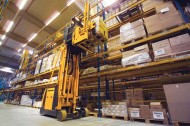 While UK sales of forklift trucks have continued to recover following the sharp fall experienced in 2009, the market for automated handling equipment has not bounced back so readily.
While UK sales of forklift trucks have continued to recover following the sharp fall experienced in 2009, the market for automated handling equipment has not bounced back so readily.
Industry statistics highlight that the market for automated materials handling projects – which include products such as stacker cranes, picking systems, mini loads etc – has remained static at best.
However, Jungheinrich UK Ltd believe that this sector is set for a period of sustained growth, as Steve Richmond, Director of Jungheinrich UK Ltd’s Systems & Projects Division, explains.
“The forklift truck market has performed very positively in the past three years and sales of very narrow aisle trucks have been buoyant too. Small to medium sized projects have also held up well. But the automated projects arena has been slow to recover.”
“But I believe that companies have now reached the point where they can no longer put-off investing in their systems and processes. The lack of investment in recent years means that, in many cases productivity and efficiency is not being maximized and, for many firms, operational costs remain higher than they need to be.
“In short , failing to invest in updated intralogistics systems is at odds with accepted business drivers.”
The majority of the growth in the automated handling sector will, Steve Richmond contends, come from mid-level solutions that can demonstrate a quick return on investment (ROI).
“Clients are looking for solutions that offer significant productivity and efficiency gains and a rapid ROI,” he says.
Steve Richmond accepts that companies such as Jungheinrich have an important role to play when it comes to creating awareness among end users of the operational benefits that modern automated and semi-automated handling systems offer.
“There can be a lack of innovative thinking among warehouse planners when it comes to adopting different solutions. Clients do not always know what products are available and what can be achieved. We do and it is up to us to demonstrate it,” he says.
According to Steve Richmond, future interest in automation will, in part, be driven by a shift in the size and scope of modern systems.
“Many users now employ partial automation – hybrid systems that are part-automated and part-manual,” he says.
“In the past some companies shied away from automation because they felt that a move to an automated system would mean that every aspect of the operation would have to be automated,” he continues.
“This is simply not the case. If designed correctly, semi- and fully-automated solutions can flexible and scalable to allow for future growth and investment strategies and that will prove very attractive.”
Jungheinrich UK Ltd
Craig Johnson
Tel: 01908 363100
Email: craigj@jungheinrich.co.uk




Comments are closed.